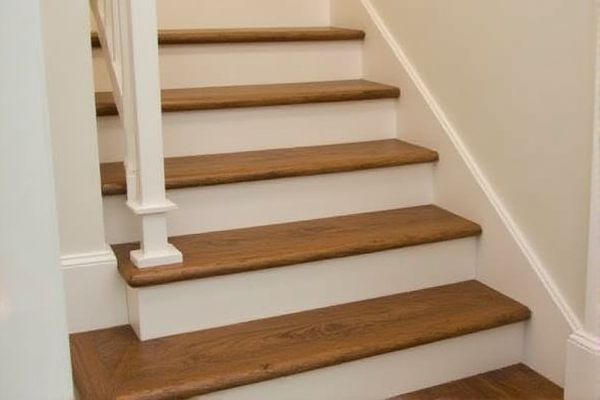
Tongue and groove treads offer superior stability and alignment by fitting snugly into one another, reducing movement and gaps typically seen with slab treads; they are ideal for staircases requiring seamless, durable construction. Discover more about choosing the best stair tread option to suit your project's needs in the rest of this article.
Table of Comparison
| Feature | Tongue and Groove Treads | Slab Treads |
|---|---|---|
| Design | Interlocking edges (tongue fits into groove) | Single solid piece, no interlocking |
| Installation | Easier alignment and stability due to interlocking joints | Requires precise fitting and adhesive for stability |
| Durability | Strong joint reduces movement and gaps | Solid piece; risk of cracking under stress |
| Cost | Typically higher due to manufacturing complexity | Generally lower, simpler manufacturing |
| Maintenance | Easier to replace individual treads | Replacement can be more difficult |
| Common Materials | Wood, engineered wood | Concrete, stone, wood |
| Use Case | Indoor stairs, flooring systems needing tight fit | Outdoor, heavy-duty stairs, minimalist designs |
Introduction to Tongue and Groove Treads vs Slab Treads
Tongue and groove treads offer interlocking edges that provide enhanced stability and alignment for staircases, reducing gaps and minimizing movement over time. Slab treads, in contrast, are solid, single-piece boards that emphasize a clean, minimalist aesthetic but may require more precise installation to avoid shifting. Choosing between these options depends on your preference for structural security versus sleek design in stair construction.
Key Differences Between Tongue and Groove and Slab Treads
Tongue and groove treads feature interlocking edges that provide enhanced stability and reduce movement between stair components, making them ideal for solid, secure staircases. Slab treads, typically a single solid piece of wood or stone, offer uniform thickness and a streamlined appearance but may require additional support to prevent shifting or cracking. The key differences lie in installation method, structural integrity, and aesthetic flexibility, with tongue and groove offering superior joint strength and slab treads providing a more seamless, monolithic look.
Material Options for Stair Treads
Tongue and groove treads offer a seamless fit by interlocking edges, commonly crafted from hardwoods like oak, maple, and cherry, ensuring durability and aesthetic appeal. Slab treads, typically solid wood or engineered wood slabs, provide a thick, sturdy surface with options ranging from natural wood to composite materials, allowing customization for style and durability. Your choice depends on the desired look, material availability, and installation preferences for long-lasting stair tread performance.
Installation Process: Tongue and Groove vs Slab
Tongue and groove treads offer a faster and more secure installation process due to their interlocking design, which ensures tight joints and reduces the need for additional fasteners. Slab treads require precise measurements and careful alignment, often needing adhesive or mechanical fasteners to hold them in place, making installation more time-consuming. Choosing tongue and groove treads can simplify your project by minimizing gaps and providing a more stable, uniform surface.
Durability and Longevity Comparison
Tongue and groove treads offer enhanced durability and longevity due to their interlocking design, which minimizes movement and reduces the risk of cracks or warping over time. Slab treads, while often thicker and sometimes more robust, can be more prone to shifting or settling without the added stability of interlocking joints. Your choice between the two should consider the specific environment and expected wear, with tongue and groove providing superior resistance in high-traffic or moisture-prone areas.
Cost Analysis: Which Tread Type Is More Affordable?
Tongue and groove treads generally offer greater affordability due to their interlocking design, which simplifies installation and reduces labor costs compared to slab treads. Slab treads, being solid, often require more precise fitting and additional support, increasing both materials and labor expenses. Evaluating your project's budget, tongue and groove treads provide a cost-efficient option without compromising structural integrity.
Design Versatility and Aesthetic Appeal
Tongue and groove treads offer superior design versatility by securely interlocking, allowing for seamless alignment and uniform appearance, which enhances aesthetic appeal in stair construction. Slab treads provide a more minimalist and robust visual style but may require additional finishing to hide joints or gaps. Choosing between these options depends on the desired architectural style and the importance of uniformity and detail in the staircase design.
Maintenance Requirements for Each Tread Type
Tongue and groove treads require regular inspection to ensure the interlocking joints remain secure and free from debris, which can cause warping or damage over time. Slab treads generally demand less frequent maintenance but may require sealing or refinishing to prevent surface wear and moisture penetration. Both tread types benefit from routine cleaning and prompt repair of any damage to maintain longevity and safety.
Common Applications and Use Cases
Tongue and groove treads are commonly used in staircases requiring precise alignment and stability, such as residential and commercial interiors where seamless joints enhance durability and aesthetics. Slab treads are favored in industrial and architectural settings for their simplicity and robustness, making them ideal for outdoor stairs, heavy foot traffic areas, and modern minimalist designs. Both types offer distinct benefits depending on the installation environment and expected wear conditions.
Choosing the Right Stair Tread for Your Project
Selecting the right stair tread depends on your project's structural needs and aesthetic preferences. Tongue and groove treads provide seamless joints that enhance stability and prevent gaps, ideal for high-traffic areas requiring durability. Slab treads, typically thicker single pieces, offer a solid, clean look with easier installation but may require additional support to avoid warping over time.
 homyna.com
homyna.com